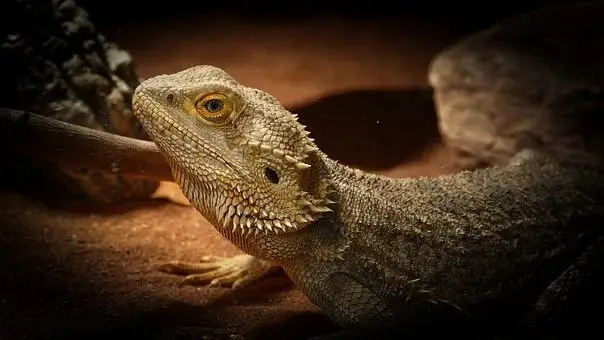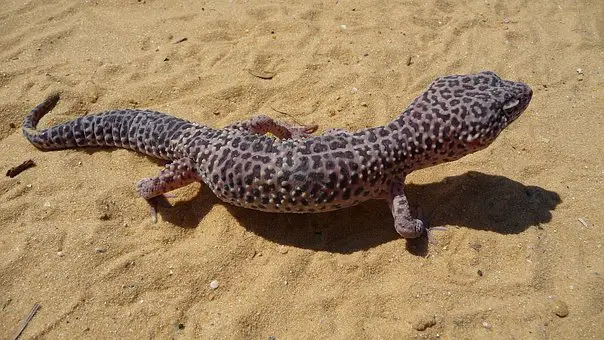Bearded dragon vs. gecko, what is best for you as a pet? There is no doubt that leopard gecko and bearded dragons are among the most friendly and smartest pets in existence. Buying a pet can be hectic especially when you are unsure about their personalities, eating habits, expenses, and more.
There are countless species of lizards, and choosing the best for your lifestyle and personality is vital. In this article, we will compile the two reptiles to help determine which one best suits your lifestyle.
In this article
Bearded dragon and leopard gecko; how do they compare?
Here is a detailed bearded dragon and leopard gecko comparison.
Appearance
Bearded dragons resemble tiny dragons with bearded that they puff up when they sense danger. They have small spikes on their body that will not hurt when handled well. Bearded dragons come in different colors such as red, gold, yellow, and stripped.

Leopard geckos feature dotted body with impressively long tails. There are several leopard gecko types that one has to choose from, and amazingly they all have different eye colors.

Bottom line: Both leopard geckos and bearded dragons look amazingly beautiful. You will have to choose what you like best.
Weight
Bearded dragons weigh about 3-4 gram after hatching. Adult bearded dragons weigh about 300 grams but have the potential to grow up to 800 grams.
Leopard gecko weighs about 50-65 grams but can grow up to 120 grams. Males, because of their bone structure, tend to weigh more than the females.
Bottom line: Some people will prefer a pet that is easy to handle, and, in that case, the leopard gecko makes a perfect choice. However, bearded dragons are not as fragile as leopard geckos, thus great for new pet owners.
Food
Bearded dragons eat both live and dead insects, vegetables, and fruits. Baby bearded dragons eat live insects and proceed to eat vegetables and gut-loaded insects twice weekly. Juvenile bearded dragons should feed twice daily until the age of 1 year, where they will reduce the frequency of feeding to once a day.
Leopard gecko feed on live insects. However, once in a while, your leopard geckos might enjoy a packet of dried insects. Baby leopard geckos need to be fed twice a day until 18 months, where they can comfortably survive on a meal a day. Since these pets do not enjoy dead insects, you will have to spend more on live insects.
Bottom line: leopard geckos can go for a week without feeding, especially during brumation. However, bearded dragons must be fed daily regardless of their age.
Tank capacity
Baby bearded dragons can live in a 20 gallons tank for about two months before a bigger tank arises. A single adult bearded dragon needs about 65-gallon tanks to move around freely.
Juvenile leopard geckos can be comfortable in a 10-gallon tank while the adult ones need 30 gallons tank for better living.9
Bottom line: It is evident that leopard geckos need less space than their counterparts bearded dragons.
Lighting, humidity, and temperature requirements
Bearded dragons love basking; their temperature should be set between 89-112 degrees Fahrenheit. Additionally, they need a high UVB tube covering about 90% of the tank. Such heat ensures that the bearded dragon digests their foods quickly and stay comfortable.
Leopard geckos are care-free animals. They are more comfortable between the temperature of 80-93 degrees Fahrenheit.
Bottom line: It is easier to meet the leopard gecko’s heating and temperature requirements. When it comes to humidity, both of these animals enjoy 30-40% humidity levels on the lower side.
Shedding
Bearded dragon brumates between the age of 12- 18 months, especially in winter. This process can take up to 3 months but can continue up to the 6th month.
Some bearded dragons will not shade. It is unlikely for those brumating to lose any weight.
Leopard geckos don’t usually brumate, but some types will. During brumation, it is usual for the pet to lose appetite and sleep more. Brumation induction is not recommended in leopard geckos unless you intend to breed them. Those who brumate may take a few months but lose between4-8 grams due to their poor eating habits during this period.
Bottom line: After winter, brumation is induced in reptile pets to help them breed. Both bearded dragons and leopard gecko can brumate for a few months.
Behavior
Bearded dragons are one the smartest reptile pets. They are fun to be around. Each bearded dragon may have a different personality, but the bottom line is that they quickly bond with the owners.
Bearded dragons love spending their day time basking out in the sun. A good number of them are calm and beautiful to watch during their various activities during the day.
Leopard geckos are mostly calm, easy to bond with, and fun to watch. These reptiles can be shy sometimes, and that explains their dislike for handling at times.
Bottom line: Both the leopard gecko and bearded dragons have outstanding personalities. However, bearded dragons are easy to handle and socialize with.
Lifespan
Leopard geckos are the best bet if you are looking for a pet that will be with you for years to come. They have an average lifespan of 20 years, primarily with proper care
A bearded dragon may live up to 14 years in a suitable environment.
Bottom line: The leopard gecko might live longer than the bearded dragon, but it all depends on the type of care you offer.
Expenses
Bearded dragons have fewer needs apart from the first tank set up. The main expense will be that of replacing the UVB tube twice a year. Food will cost less than $40 weekly for an adult bearded gecko.
Leopard geckos may not need UVB heating luxury but will require live insects and a tank heater.
Bottom line: Both leopard gecko and bearded dragons require insects throughout their life. Food costs will be much lower if you decide to breed your feeder bugs. Veterinary services are likely to depend on the medical issue at hand. It is best to save upfront.
Can bearded dragon live with leopard gecko?
Regardless of how much you love the two pets, they should never be kept in the same habitat. Do not be tempted to make these two species tank mates; it will end in disaster.
Habitat requirements
Bearded dragons originated from Australia’s woodlands; they play a lot in the sun during the day. The sun makes them excited and healthy. Like pets, you require a UVB bulb with a high wattage to help keep temperatures as desired. Bearded dragons sleep quite a lot during the night and spend the day hunting for insects and leaves.
Leopard geckos come out of their habitat at night to hunt for insects. These reptiles do not require any lighting in their habitant. Like pets, you will not need a UVB bulb but a heating pad under their belly to keep digestion optimal.
In other words, the two species have different temperature, lighting, and humidity needs. While the bearded dragon needs a lamp to keep warm, the leopard gecko-like belly heating using hot stone or a heating pad. This clearly shows that it will not be easy to create a suitable environment for both of these creatures. It is also important to note that some types of leopard gecko are sensitive to UVB lamps.
You can do almost nothing to make it comfortable for both of them to exits in one tank.
Competition
Male leopard gecko and female bearded dragons are very competitive. This means that both pets do not wish to have an intruder in their habitant.
Male bearded dragons are aggressive animals and will take every chance to kill an intruder who, in this case, is the leopard gecko.
Leopard geckos are friendly but very territorial; they will try their best to kill any intruder in their tank. Remember, Leopard geckos are nocturnal animals; there is a chance that they can attack the bearded dragon when they are deep sleep.
They carry diseases
There is a small chance that you have a large habitat, making it harder for the two animals to meet.
You will have a vast parasite problem to deal with
Both these reptiles carry parasitic diseases. The problem is that each pet has different types of parasites that can harm the other.
Parasites are excited through feces in reptiles. There is a chance that one of the snakes can get infected from moving around. This means that it is easy for your leopard gecko to transmit viruses, bacteria, or parasites to the bearded dragon or the other way round.
Bearded dragon vs. leopard gecko, which one is suitable for me?
From our comparison notes above, it is evident that both bearded dragons and leopard geckos make great pets. Either of them will make you a proud owner.
Bearded dragons are best for children because of their ability to show multiple personalities but are expensive to maintain compared to the leopard geckos.
Leopard gecko is easy to care for and occupy less tank space.
Regardless of the pet you choose, we hope that this article helped you make the right decision.


